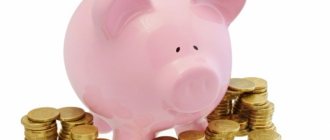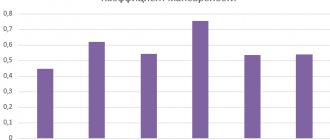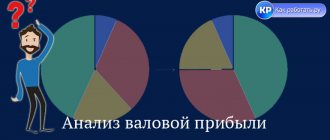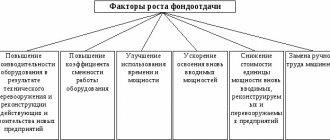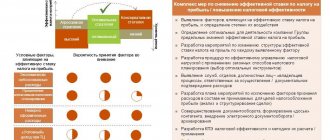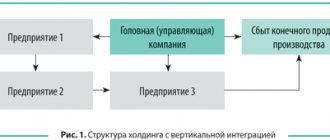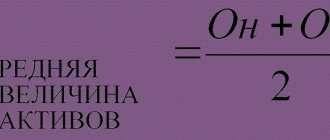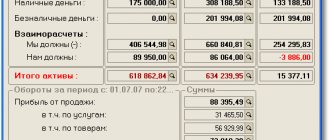Fixed costs are an indicator of great practical importance in determining the profitability of a company, as well as optimizing its business model. We will tell you in our article how to calculate them correctly and what components they can be represented by.
What indicators relate to fixed costs?
Why calculate fixed costs for a company (examples of their practical application)
How to calculate fixed costs (formula of the corresponding indicator and its components)
Interest on loans and wages in the form of bonuses are semi-fixed costs?
Results
What indicators relate to fixed costs?
Fixed costs include costs that, on the one hand, do not correlate with the volume of production of goods and services (do not increase or decrease depending on their growth or decline), and on the other hand, remain relatively stable in value. In turn, costs that depend on the rate of production of goods and services are classified as variable costs.
Important! As a rule, the larger the production volume, the less fixed costs there are per 1 unit of product produced by the enterprise. As a result, the profitability of the business increases: at a certain point, the company reaches the break-even point and then becomes profitable.
What costs, independent of the volume of output of goods and services, are we talking about?
First of all, this may be staff salaries (as well as mandatory payments tied to it, for example in the form of contributions to government funds). Relatively speaking, 10 people on a company’s staff can, by managing the existing production infrastructure, produce 100 or 200 units of a particular product and receive the same salary.
Fixed costs include paying for the rental of production premises. Most often, it is calculated only based on the area of the corresponding object, which remains unchanged. The landlord, as a rule, is not interested in production volumes and other business indicators from the point of view of setting prices for rented premises.
https://youtu.be/mAdmXvu0DSU
Production costs and their classification.
LECTURE 6 COSTS AND PROFIT
1.Production costs and their classification. 1
2. Categories of fixed, variable and general (gross) costs. 3
3. Costs per unit of production: average gross, average fixed and average variable costs. 4
4. The relationship between average and marginal costs with average and marginal productivity. 5
5.Gross, average and marginal income of a company under conditions of perfect competition. 6
6.Normal, accounting and economic profit. 6
7. Costs and profits of a competitive firm in the short term. Principles of profit maximization. 7
Production costs are the monetary value of the materials and other factors of production used to make a product.
Types of costs:
1). By number of manufacturers:
— Public (society is a single producer).
OI = Private ed. + Ext. effects
— Private (in the case of an individual producer).
2). By quantitative assessment:
— Monetary form (production costs represent the cost of expended resources in the actual prices of their acquisition);
- Natural form. In this case, on the one hand, this is a set of resources spent in the production of a given volume of products, and on the other hand, these are opportunity costs, which express the number of other products that could be produced instead of this one using the same resources
3). By quantity of issue:
— General (for the entire volume of products) – TS;
— Average (per unit of production) – AC;
— Limit ( ) — MS.
4). By time period and relationship with production volume:
— Fixed (FC) – costs, the value of which does not change with an increase or decrease in production volume (EXAMPLE: costs associated with the use of buildings, structures, machinery and production equipment, rent, major repairs, administrative expenses).
— Variables (VC) – costs, the value of which changes with an increase or decrease in production volume (EXAMPLE: costs of raw materials, electricity, auxiliary materials, labor).
5). External and internal costs:
— External (explicit) costs – cash payments for resources attracted for production.
— Internal (implicit) costs are the costs of one’s own unpaid resources and benefits that are not reflected in accounting.
External costs + internal costs = Economic costs
6). Economic and accounting:
— Economic costs (imputed) are the alternative cost of resources diverted for a given production.
— Accounting are actual expenses incurred in cash associated with the implementation of production.
7). Returnable and sunk costs :
— Return costs are expenses that the company is able to return.
— Sunk costs - the company cannot return expenses (advertising, obtaining a license, making stamps, purchasing special equipment), this is the company’s fee for entering/exiting the market.
8). Transformation costs are associated with the transformation of material objects.
9). Transaction costs are associated with the interaction of owners, with the completion of transactions or the implementation of property rights.
10). Capital costs are the costs of acquiring or creating fixed capital, which are used for a long time in the production process, but are consumed gradually (costs of purchasing buildings, structures, etc.).
eleven). Current costs are the costs of resources consumed over a certain period of time (costs of raw materials, labor, etc.).
In economics, costs are understood as costs calculated based on the principle of minimizing costs for producing a certain volume of output.
Fixed costs (FC – fixed costs) are costs that do not depend on the volume of output, and with an increase or decrease in the utilization of a company’s production capacity, they remain constant. Fixed costs include: rental payments, depreciation of production facilities, buildings, equipment, wages for the company’s administrative staff, insurance, etc.
Graphically, the fixed cost function can be shown as follows:
Rice. 1.8. Fixed costs
However, fixed costs remain unchanged only in the short term. In the short term, the company increases its output due to more intensive use of products, and not by expanding production capacity. Those. This means that the scale of the firm does not change.
In the long term, fixed costs are transformed, since with a change in the scale of the company (with a change in the volume of production capacity), the level of fixed costs also changes. The general rule is that in the long run, as output increases, fixed costs also increase[1].
Variable costs (VC – variable costs) are costs, the value of which depends on the volume of output of the company. Variable costs include: costs for electricity and fuel, raw materials, materials, labor, transportation services, etc.
Graphically, the variable cost function looks like this:
Rice. 2.8. Variable costs
There is a section on the graph with a relatively small slope, between points a and b , in which variable costs grow at a slowing pace. After point b , the line rises steeply, which is explained by a sharp increase in the costs of variable resources with a further increase in production.
This means that at this stage the productivity of the variable resource decreases and more of it is required to produce each subsequent unit of output, and here the effect of diminishing returns begins to work.
Total costs (TC – total costs) are the sum of fixed and variable costs.
TC = FC + VC
Graphically it looks like this:
Rice. 3.8. General costs
Since the total cost function is an overlay of the variable cost function on the fixed cost function, one can very easily conclude that at zero output the amount of total costs will be equal to the amount of fixed costs. When production starts and increases, total costs will increase by the amount of variable costs.
3. Costs per unit of production: average gross, average fixed and average variable costs.
Average costs (AC – average costs) are calculated on the basis of total costs and represent the arithmetic average cost of a unit of production.
They are calculated by dividing the total costs by the number of products produced.
AC = TC : Q
Rice. 4.8. Average costs
The average cost graph shows: at the beginning of production, average costs are high, but as production volume increases, they begin to decline, and at the decreasing segment of the average cost function, production growth exceeds total costs. The lowest value of average costs is indicated by the minimum point on the graph, but with further growth in production, average costs increase under the influence of an increase in total costs. In this case, the effect of diminishing returns comes into play again.
There are also:
Average fixed costs (AFC - average fixed costs) - are determined by dividing fixed costs by production volume.
AFC = FC : Q
Average variable costs (AVC – average variable costs) are determined by dividing variable costs by production volume.
AVC = VC : Q
Average total costs (ATC - average total costs) - are determined by dividing total costs by production volume.
ATC = TC : Q = (FC : Q) + (VC : Q) = AFC + AVC
Why calculate fixed costs for a company (examples of their practical application)
The practical significance of calculating fixed costs lies mainly in the use of the corresponding indicator to determine the very break-even point of the business. It can be considered achieved after the enterprise’s revenue becomes equal to the sum of all its expenses, including fixed costs .
Another possible option for the practical application of the results of calculating fixed costs is optimizing the business model by legally and expediently reducing relevant costs. For example, if it turns out that the structure of fixed costs is dominated by staff salaries (together with payments to state funds), the company’s management may decide to transfer a number of labor functions to outstaffing, in which contributions to state funds are not required.
True, the labor compensation itself under an outstaffing contract may increase (since the company for which the agency employee works will, one way or another, need to make payments for him to the Pension Fund of the Russian Federation, the Social Insurance Fund and the Federal Compulsory Compulsory Medical Insurance Fund). But, as a rule, savings can be made, for example, by reducing the working hours of an outstaffing employee’s presence at the enterprise.
The main purpose of calculating variable costs
Any economic indicator serves a single goal - increasing the profitability of the enterprise. Variable costs are no exception. They allow you to analyze the company’s activities and develop a strategy for increasing profitability. Accordingly, this indicator is not included in the balance sheet, since it is needed not for accounting, but for management accounting.
Important! There should be a clear distinction between fixed and variable costs. The first are those whose amount does not change for a long time. For example, office rent, training, retraining of company employees and other fixed costs.
How to calculate fixed costs (formula of the corresponding indicator and its components)
As we noted above, fixed costs include those costs that do not depend on the volume of production of goods and services. Their calculation will actually be an operation of adding up the corresponding costs. We have already identified their 2 most common types: staff salaries and premises rental.
However, there are also a number of other key components of fixed costs , namely:
- depreciation;
- property taxes;
- advertising and promotion expenses;
- security costs;
- others.
Thus, the formula for calculating fixed costs will look very simple - like an operation of adding up the amounts spent on staff salaries, rent, depreciation, property deductions, advertising expenses, etc. for the reporting period (for example, a month).
Costs such as interest payments on loans and wages under bonus schemes have a special status. The fact is that most often they are classified as so-called semi-fixed costs. Let's study their specifics in more detail.
Variable costs of the enterprise. Definition and their economic meaning
Variable costs of an enterprise (English: Variable Cost, VC) are the costs of an enterprise/company that vary depending on the volume of production/sales. All costs of an enterprise can be divided into two types: variable and fixed. Their main difference is that some change with increasing production volume, while others do not. If the company's production activities cease, then variable costs disappear and become equal to zero.
Variable costs include:
- The cost of raw materials, materials, fuel, electricity and other resources involved in production activities.
- Cost of manufactured products.
- Wages of working personnel (part of the salary depends on the standards met).
- Percentages on sales to sales managers and other bonuses. Interest paid to outsourcing companies.
- Taxes that have a tax base based on the size of sales and sales: excise taxes, VAT, unified tax on premiums, tax according to the simplified tax system.
| ★ InvestRatio program - calculation of all investment ratios in Excel in 5 minutes (calculation of Sharpe, Sortino, Treynor, Kalmar, Modiglanca beta, VaR ratios) + forecasting rate movements |
What is the purpose of calculating the variable costs of an enterprise?
Behind any economic indicator, coefficient and concept one should see their economic meaning and the purpose of their use. If we talk about the economic goals of any enterprise/company, then there are only two of them: either increasing income or reducing costs. If we summarize these two goals into one indicator, we get the profitability/profitability of the enterprise. The higher the profitability/profitability of an enterprise, the greater its financial reliability, the greater the opportunity to attract additional borrowed capital, expand its production and technical capacities, increase intellectual capital, increase its value in the market and investment attractiveness.
The classification of enterprise costs into fixed and variable is used for management accounting, and not for accounting. As a result, there is no such item as “variable costs” in the balance sheet.
Determining the size of variable costs in the overall structure of all enterprise costs allows you to analyze and consider various management strategies for increasing the profitability of the enterprise.
Amendments to the definition of variable costs
When we introduced the definition of variable costs/costs, we were based on a model of linear dependence of variable costs and production volume. In practice, variable costs often do not always depend on the size of sales and output, so they are called conditionally variable (for example, the introduction of automation of part of the production functions and, as a result, a reduction in wages for the production rate of production personnel).
The situation is similar with fixed costs; in reality, they are also semi-fixed in nature and can change with production growth (increasing rent for production premises, changes in the number of personnel and a consequence of the volume of wages. You can read more about fixed costs in detail in my article: "Fixed costs. Formula. Definition. Example of calculation in Excel."
Interest on loans and wages in the form of bonuses are semi-fixed costs?
Yes, most often this is true. Conditionally fixed costs, like traditional fixed costs , do not correlate with the volume of goods produced, but in one way or another change over time due to other factors.
With regard to interest on loans, this is due to the fact that the share of the corresponding interest in the structure of monthly payments specified in the agreement with the bank in the first months of settlement is, as a rule, noticeably higher than in the last.
In turn, staff salaries, calculated primarily based on the size of the bonus component, are also likely to be very volatile. Such remuneration schemes are typical, for example, for sales managers and top managers.
Conditionally fixed costs, of course, also influence the determination of the break-even point of an enterprise, as well as any other costs.
Classification of enterprise variable costs
In order to better understand how to understand what variable costs are, consider the classification of variable costs according to various criteria:
Depending on the size of sales and production:
- Proportional costs. Elasticity coefficient =1. Variable costs increase in direct proportion to the growth of production volume. For example, production volume increased by 30% and costs also increased by 30%.
- Progressive costs (analogous to progressive-variable costs). Elasticity coefficient >1. Variable costs have a high sensitivity to change depending on the size of output. That is, variable costs increase relatively more with production volume. For example, production volume increased by 30% and costs by 50%.
- Degressive costs (analogous to regressive-variable costs). Elasticity coefficient < 1. With increasing production growth, the variable costs of the enterprise decrease. This effect is called the “scale effect” or “mass production effect.” For example, production volume increased by 30%, but variable costs increased only by 15%.
The table shows an example of changes in production volume and the size of variable costs for their various types.
| Type of cost sensitivity | Change in production volume | Changing the size of variable costs |
| Proportional costs | +30% | +30% |
| Progressive costs | +30% | +50% |
| Degressive costs | +30% | +15% |
According to statistical indicators, there are:
- Total variable costs (English: Total Variable Cost, TVC) - include the totality of all variable costs of the enterprise across the entire range of products.
- Average variable costs (AVC, Average Variable Cost) – average variable costs per unit of product or group of goods.
According to the method of financial accounting and attribution to the cost of manufactured products:
- Variable direct costs are costs that can be attributed to the cost of goods manufactured. Everything is simple here, these are the costs of materials, fuel, energy, wages, etc.
- Variable indirect costs are costs that depend on the volume of production and it is difficult to assess their contribution to the cost of production. For example, during the industrial separation of milk into skim milk and cream. Determining the amount of costs in the cost price of skim milk and cream is problematic.
In relation to the production process:
- Production variable costs - costs of raw materials, supplies, fuel, energy, wages of workers, etc.
- Non-production variable costs are costs not directly related to production: commercial and administrative expenses, for example: transportation costs, commission to an intermediary/agent.
| ★ InvestRatio program - calculation of all investment ratios in Excel in 5 minutes (calculation of Sharpe, Sortino, Treynor, Kalmar, Modiglanca beta, VaR ratios) + forecasting rate movements |
Results
Fixed costs have 2 key features: a relatively stable value, as well as a lack of correlation with the volume of output of goods or services. In turn, if only the 2nd criterion is met, then the corresponding costs are more appropriately classified as semi-fixed costs.
fixed costs most in demand when calculating the break-even point, as well as solving problems of optimizing a company’s business model through reasonable reduction of certain types of relevant costs.
You can learn more about other components of analyzing the economic efficiency of an enterprise in the articles:
- “Financial leverage ratio - formula for calculation”
- “Calculation of marginal profit (formula and nuances)”
You can find more complete information on the topic in ConsultantPlus. Full and free access to the system for 2 days.
Calculation of unit variable costs
Definition 3
Specific variable costs are the ratio of the sum of variable costs and the volume of sales of goods in physical terms.
Using the breakeven point, you can determine the minimum acceptable size of an enterprise, below which the business is considered ineffective. In addition, the indicator of specific variable costs allows us to obtain reliable data on unprofitable and profitable areas that appear at a certain value of production volume. This allows the management of the enterprise to foresee the prospects for the impact of its decisions in terms of increasing the costs of materials, raw materials, and capital on the level of profitability of the business.
Too lazy to read?
Ask a question to the experts and get an answer within 15 minutes!
Ask a Question
Note 1
Specific variable costs decrease as production volume increases due to the distribution of fixed costs over the entire production volume.
The value of calculating specific variable costs lies not in defining these indicators in the business plan at a critical level, but in establishing an area limited, on the one hand, by the critically minimum value of the indicators, and on the other hand, by the maximum permissible value, highlighting in this area there are zones with varying degrees of risk.
An increase in specific variable costs leads to an increase in the break-even point of production, as well as a decrease in the share of marginal income in the price of the product.
Detailed instructions for calculating variable costs
To calculate costs, you will need to determine the material costs of production. This is done on the basis of the following documents:
- reports on the write-off of raw materials, consumables and other materials for the production of goods;
- certificates of work completed for the main and auxiliary production processes;
- reports of outsourcing companies involved in production;
- return certificates for waste materials.
Important! The amount of material costs includes data only on the first three items from this list. The last item (about the return of waste) is deducted from the amount of costs.
Then you need to determine the amount of costs for paying the variable part of salaries to employees of the enterprise. This includes bonuses, interest, commissions, allowances, payments to the Social Insurance Fund and other types of additional payments.
Based on data on actual consumption and prices established in the region of production, the amount of costs for utility costs and fuel is determined.
After this, the amount of costs for packaging, storage and delivery of products is calculated. This can be done on the basis of internal company documents or reports from third-party organizations responsible for these stages of work.
After all this, the amount of tax costs is determined based on the company’s declarations or accounting reports.
Important! Please note that it is possible to reduce variable costs of taxes, fees and other mandatory payments only by making appropriate changes to federal or regional legislative acts. However, they must be taken into account when calculating.
Conditionally fixed costs
Definition 1
Conditionally fixed costs are costs that are not related to the volume of output, changing in quantity and/or quality in the process of business activity, and capable of turning into variable costs after a certain period of time.
Conditionally fixed costs include:
- rent. The indicator is not affected by production volume, however, the rental price may decrease or increase, and the rented area may also change. This characterizes a quantitative change. If an entrepreneur buys out this leased space or buys another premises, this will entail another quantitative change - the payment of depreciation charges, which should be lower than rental payments. And the very fact of repurchase/purchase of new premises is a characteristic of a structural change in variable costs. If we talk about a structural change, then it will also take place in the case described above, if, for example, an entrepreneur used a loan to purchase a new premises, then even with an equal amount of fixed costs, their structure has changed (depreciation deductions + payment of interest on the loan);
- accounting department salaries. As the staff expands, the volume of expenses increases, however, if accounting is transferred to an outsourcing company, the volume of costs will decrease;
- payment of certain taxes. Fixed costs, for example, include property tax or unified social tax. The change in costs can be clearly seen using the example of property tax - an increase in it in the case of the acquisition of new property or its revaluation will lead to an increase in fixed costs, and a decrease (sale of property and the same revaluation) will lead to a decrease in costs.
Finished works on a similar topic
- Course work Conditional costs 480 rub.
- Abstract Contingent costs 250 rub.
- Test work Conditional costs 230 rub.
Receive completed work or specialist advice on your educational project Find out the cost
If, when producing products, an enterprise first produces components (or their parts), and then, due to a decrease in the volume of incoming orders, moves on to obtain components from a third-party manufacturer, fixed costs will turn into variable ones. Part of the fixed costs will go in the form of depreciation, and the cost of the components received will be classified as variable costs.

